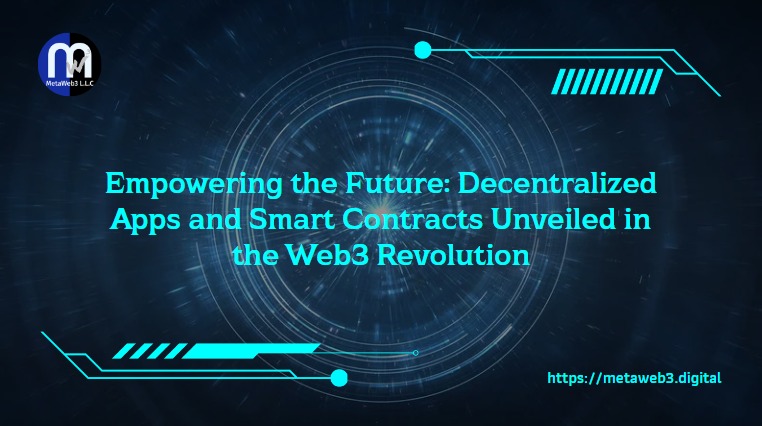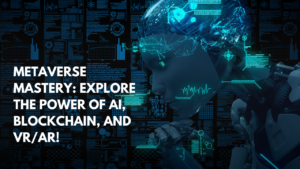Elevate Your Pressure Washing Business: The Ultimate Digital Marketing Guide...
Read MoreInformative Blog Series: Chapter 3

Table of Contents
Introduction
Welcome to the third installment of our Web3 Technology Explainer Series! In this edition, we delve into the fascinating realms of decentralized applications (DApps) and smart contracts, pivotal components shaping the landscape of Web3. Understanding the decentralized nature of applications and the revolutionary concept of intelligent contracts becomes paramount as the digital realm continues to evolve. Join us on this exploration as we unravel the intricacies of DApps, software applications that operate on a decentralized network rather than a central server. Furthermore, we will demystify the transformative power of smart contracts, self-executing contracts with the terms of the agreement directly written into code. By the end of this blog, you’ll gain insights into the potential impact of DApps and smart contracts on the future of the internet, ushering in a new era of transparency, security, and efficiency. Let’s navigate the complexities of Web3 together and unlock the potential of decentralized technologies.
What are Decentralized Apps?
Decentralized applications, or DApps, are a fundamental component of Web3 technology. Unlike traditional applications that rely on centralized servers, DApps operate on a decentralized network of computers using blockchain technology. In the context of Web3, these applications leverage the principles of decentralization, transparency, and cryptographic security. DApps typically have their backend code running on a peer-to-peer network, often a blockchain, ensuring that no single entity controls the entire application. Users interact with DApps through front-end interfaces, accessing services or functionalities while benefiting from the distributed and trustless nature of the underlying technology. This decentralization enhances security and promotes transparency by allowing users to verify transactions and data on the blockchain. Decentralized applications are pivotal in reshaping the digital landscape by offering a more inclusive, secure, and transparent way of delivering services and functionalities.
Roles of Decentralized apps:
- Decentralized applications (DApps) play a transformative role in Web3 technology by introducing fundamental principles such as decentralization, transparency, and security. One of their primary roles is to shift control from a central authority to a distributed network, eliminating single points of failure and reducing the risk of censorship—DApps leverage blockchain technology to ensure a tamper-resistant and transparent record of transactions and data.
- In Web3, DApps facilitate peer-to-peer interactions, allowing users to transact and communicate directly without intermediaries, which fosters a trustless environment and reduces dependency on traditional, centralized systems. Smart contracts, a core component of many DApps, enable self-executing agreements with predefined rules, automating processes and enhancing efficiency.
- Moreover, DApps contribute to democratizing data, empowering users with ownership and control over their information. Through decentralized storage solutions, users can secure their data without relying on centralized servers, mitigating privacy concerns.
- Overall, the role of decentralized applications in Web3 is to redefine how we interact with digital services, promoting a more equitable, secure, and user-centric Internet experience. They represent a crucial step towards a decentralized future, where individuals have greater autonomy and trust in online interactions.
What are Smart Contracts?
Smart contracts are a foundational element of Web3 technology, playing a crucial role in automating and executing agreements without intermediaries. In the context of Web3, smart contracts are self-executing contracts with the terms of the agreement directly written into code. When predefined conditions are met, decentralized blockchain platforms like Ethereum and Binance Smart Chain automatically enforce and execute the agreed-upon terms in these contracts.
Enable automation and trust in Web3:
Smart contracts in Web3 technology enable automation and trust through their inherent features and the decentralized nature of blockchain platforms. Here’s how:
Self-execution:
Smart contracts automatically execute predefined actions when specific conditions are fulfilled. This automation eliminates the need for intermediaries or manual intervention, streamlining processes and reducing the risk of errors.
Decentralization:
Smart contracts run on decentralized blockchain networks, ensuring no single entity controls the assurance. This decentralization contributes to trust by removing the reliance on a central authority. Participants can trust that the code will execute as intended without interference.
Immutability:
Once deployed on the blockchain, smart contracts maintain immutability, signifying that their code cannot undergo alterations. This immutability ensures that the terms of the agreement remain tamper-resistant, providing a reliable and transparent record of transactions.
Transparency:
The blockchain’s public ledger records the terms and execution of smart contracts. This transparency allows participants to independently verify the details of a contract, fostering trust among involved parties.
Trustless Interactions:
Smart contracts facilitate trustless interactions by ensuring that parties don’t need to trust each other. The code and the decentralized network position the trust, reducing the risk of fraud or manipulation.
In summary, intelligent contracts enable automation by executing actions autonomously and contribute to trust in Web3 by leveraging decentralization, immutability, transparency, and cryptographic security. This combination of features makes smart contracts a powerful tool for redefining how agreements are made and executed in a decentralized and trustworthy manner.
Showcase real-world examples of dApps and smart contracts, like DeFi platforms and supply chain management.
Certainly! Here are real-world examples of decentralized applications (DApps) and smart contracts in various domains:
DeFi Platforms:
In the decentralized finance (DeFi) platform domain, numerous real-world examples of decentralized applications (DApps) and smart contracts have emerged, transforming traditional financial services. Uniswap, a decentralized exchange (DEX), operates as a DApp on the Ethereum blockchain, allowing users to swap various tokens directly from their wallets without relying on a centralized intermediary. Smart contracts govern the automated and trustless execution of these token swaps. Compound Finance is another notable example, functioning as a decentralized lending protocol. Users can lend and borrow cryptocurrencies through a user-friendly DApp, while intelligent contracts manage interest rates dynamically based on supply and demand. MakerDAO, a decentralized autonomous organization (DAO), issues the stablecoin Dai through innovative agreements collateralized by various assets. Aave, a decentralized lending platform, utilizes intelligent contracts with unique features like flash loans to facilitate lending and borrowing. These examples highlight how DApps and smart contracts in the DeFi domain provide users with decentralized alternatives to traditional financial services, fostering transparency, accessibility, and innovation.
Supply Chain Management:
Decentralized applications (DApps) and smart contracts have found substantial applications in the supply chain domain, enhancing transparency, traceability, and efficiency. One compelling example is VeChain, a blockchain platform designed for supply chain management. VeChain’s DApp enables businesses to record and track every stage of a product’s lifecycle, from manufacturing to distribution, using unique identifiers stored on the blockchain. Smart contracts within the system automatically execute agreements, such as verifying product authenticity or triggering payments upon successful delivery. Another notable example is IBM Food Trust, a decentralized application built on the Hyperledger Fabric blockchain. It allows participants in the food supply chain to trace the origin and journey of food products, enhancing food safety and reducing inefficiencies. Intelligent contracts are vital in automating compliance checks and ensuring that predefined conditions, like temperature thresholds during transportation, are met. These applications showcase how DApps and smart contracts in the supply chain domain enhance visibility, accountability, and trust across complex global networks.
Gaming
In the gaming domain, decentralized applications (DApps) and smart contracts are reshaping the traditional gaming experience by introducing transparency, ownership, and new economic models. One notable example is Decentraland, a virtual reality platform built on the Ethereum blockchain. In Decentraland, users can create, buy, and sell virtual land parcels as non-fungible tokens (NFTs), enabling actual ownership and decentralized governance over the virtual world. Smart contracts govern the transactions and interactions within Decentraland, ensuring the integrity of in-game assets and the execution of scripted events. Another example is Axie Infinity, a blockchain-based game where players can collect, breed, and battle fantasy creatures known as Axies. Smart contracts on the Ethereum blockchain govern the creation and trading of Axies as NFTs, providing players with actual ownership of their in-game assets. These examples highlight how DApps and smart contracts in the gaming industry empower players with ownership of digital assets, interoperability between games, and novel economic opportunities within virtual worlds.
Content Distribution:
In the content distribution domain, decentralized applications (DApps) and smart contracts are revolutionizing digital content creation, sharing, and monetizing. Steemit, a blockchain-based social media platform, operates as a DApp where users are gifted with cryptocurrency for creating and curating content. Smart contracts automatically distribute rewards based on the engagement and popularity of the content. Another example is LBRY, a decentralized content-sharing platform where users can publish, share, and monetize digital content. LBRY utilizes smart contracts to automate the payment process, ensuring content creators receive direct compensation from consumers without intermediaries. These applications showcase how DApps and intelligent contracts empower content creators by providing immediate and transparent monetization avenues while offering consumers a decentralized and censorship-resistant platform for discovering and accessing a wide range of digital content.
Conclusion
In conclusion, exploring Web3 technology in this series has unveiled a transformative landscape that promises to redefine how we interact with the digital world. Web3 opens up new possibilities for trustless and transparent systems, from decentralized applications to blockchain-powered intelligent contracts. As we navigate the evolving terrain of decentralized finance, non-fungible tokens, and decentralized autonomous organizations, it becomes evident that the decentralized nature of Web3 fosters innovation, security, and inclusivity. The potential for a more equitable and user-centric internet is within reach, as Web3 empowers individuals to have greater control over their data and digital assets. However, as we embrace the promises of this technology, it is essential to navigate the challenges responsibly, addressing issues of scalability, interoperability, and governance. The journey into the era of Web3 is not only a technological advancement but also a societal shift towards a more decentralized, open, and participatory digital future.
The Rise of Voice Search: Optimizing Content for Smart Speakers
The Rise of Voice Search: Optimizing Content for Smart Speakers...
Read MoreMetaverse Mastery: Explore the Power of AI, Blockchain, and VR/AR!
Metaverse Mastery: Explore the Power of AI, Blockchain, and VR/AR! Table of...
Read MoreImmersive Horizons: Exploring Metaverse Technology’s User Experience and Challenges
Immersive Horizons: Exploring Metaverse Technology’s User Experience and Challenges Table...
Read More





